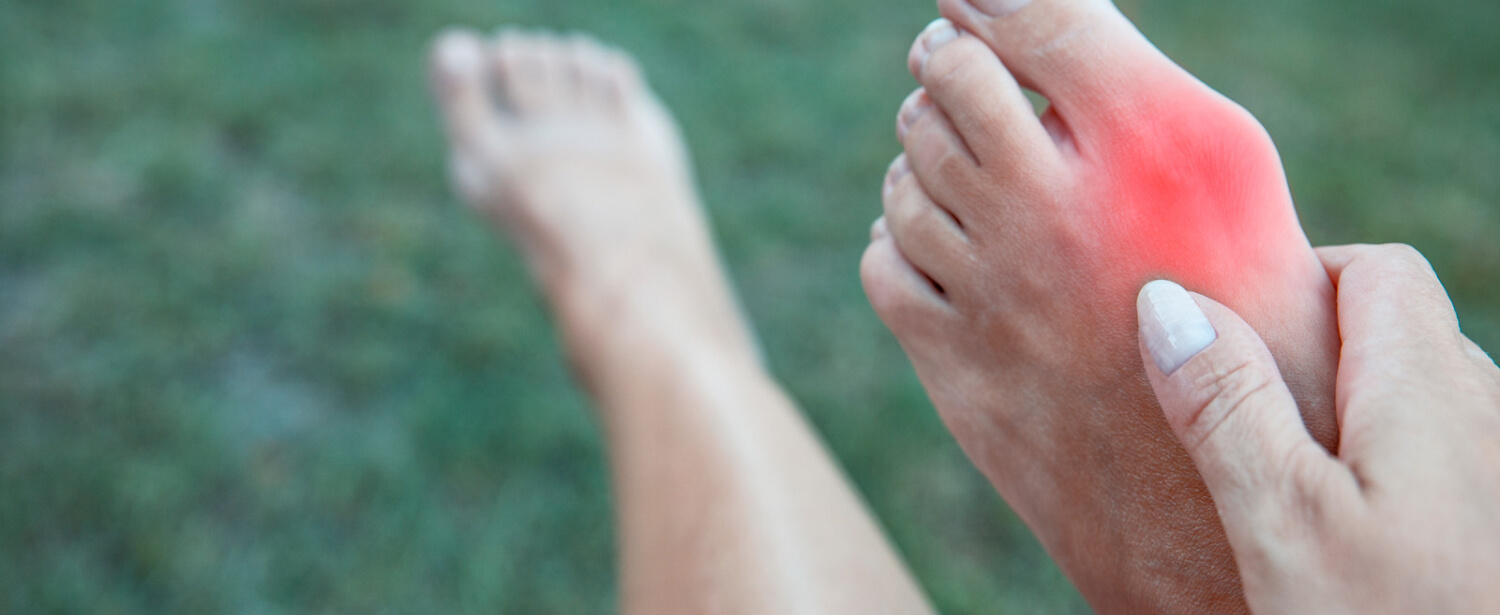
Bunions – Overview
A bunion is a bony bump that forms on the joint at the base of the big toe. Bunions form when some of the bones in the front part of the foot move out of place. This causes the tip of the big toe to get pulled toward the smaller toes, crowding them. This forces the joint at the base of the big toe to stick out. The skin over the bunion could be red and sore. The clinical term for this foot condition is hallux valgus.
Speaking of bunion causes, bunions can be formed or worsened by wearing tight, narrow shoes. They can also form due to the shape of your foot, a foot deformity or a medical condition, such as arthritis. Smaller bunions, known as bunionettes, can form on the joint at the base of the little toe.
The exact bunion causes are unclear. Bunion pain symptomsare more likely to occur in people who were born with an abnormal foot structure, or have improper walking mechanics or who are experiencing a foot injury. These conditions increase pressure on the big toe joint, leading to formation of bunions. Other bunion causes are rheumatoid arthritis,and wearing tight-fitting or high-heeled shoes which increase the risk of developing bunions in those who are more prone.
What Does Bunion Pain Feel Like?
Bunion pain symptoms can range from mild to severe. It can feel different for everyone. Bunion pain can be constant or could only flare up sometimes. Some people experience throbbing bunion pain at night in the big toe, or a pain that extends into the ball of the foot throughout the day. In cases where the swelling in the toe joint presses against a nerve, shooting pain could be experienced.
If the big toe is turned in and crowds the toe next to it, pain could be experienced in multiple areas. This type of turning in of the big toe could also lead to another painful condition known as hammertoe.
Pain can also be experienced where the actual bunion growth sticks out from the rest of the foot and rubs against the side of one’s shoe.
Bunion Pain Symptoms
Here are some of the symptoms of a bunion…
- A bony bump or protrusion on the outer side of the big toe joint
- Pain around the big toe joint, that usually becomes worse while wearing shoes and walking
- Swelling or redness at the big toe joint
- Formation of a callus where the big toe rubs against the next toe
- Reduced mobility in the big toe is another of the symptoms of a bunion
How Can You Get Rid Of Bunion Pain?
Here are a few at-home remedies to help you deal with bunion pain symptoms…
Choose… the right shoes. It is beneficial to use low-heeled shoes with a wide toe box. This reduces the pressure on your big toe and provides plenty of room for the foot.
Add… cushioning. Wear a bunion pad to keep your big toe from rubbing against your shoe.
Stretch… your feet and toes. Foot exercises and toe stretches are beneficial as they help to keep the joint between your big toe and the rest of your foot flexible.
Apply… ice. Ice is a helpful remedy to deal with pain. Try icing your big toe for ten minutes after exercising, walking or when experiencing pain.
Try… a pain reliever. Occasional bunion pain can be relieved by using over-the-counter options, such as acetaminophen or ibuprofen. That said, do check with your medical practitioner to ensure they don’t interfere with your other medications. Also, consume them only as directed.
Do inform your doctor if these at-home remedies do not help relieve your bunion pain.
Other Bunion Treatment Options
There are additional bunion treatment options to reduce inflammation and achieve better pain relief…
Bunion pain relief can be offered by using specialised shoe inserts, called orthotics. A splint could also be worn at night. Both these can help to align and support the foot and can be effective forms of bunion pain treatment.
Physical therapy can also help reduce pain and inflammation. Though it is a lengthier and time-intensive option of bunion treatment, it can deliver results.
These types of bunion treatment could help slow down the worsening of bunions. However, bunions cannot be prevented completely.
When Should You Consider Bunion Surgery?
Bunions are initially treated using conservative therapies. However, in cases where the nonsurgical bunion treatment options are not effective, bunion surgery can be considered. Also called a bunionectomy, bunion surgery is reserved only when pain is severe or mobility is limited. It is not conducted only for cosmetic reasons.
Bunion surgery aims to restore the normal positioning and alignment of the big toe joint. There are different surgical techniques used to correct a bunion and offer bunion pain relief. After surgery and recovery from the bunion pain treatment procedure, people experience significant bunion pain relief.
The recovery time depends on the specific issue and the surgical technique used to correct it. It can range from six to 12 weeks.
Post-bunion surgery, it is still recommended to choose conservative footwear. This means avoiding high heels and narrow shoes.
Conclusion
If you experience any of the symptoms of a bunion, before starting bunion pain treatment, it is recommended to get an official diagnosis from a podiatrist (a medical specialist who helps with problems that affect your feet or ankles). Following the diagnosis, you can work on a treatment plan together for bunion pain relief. A podiatrist would be able to confirm if a bunion is growing or whether you are experiencing other foot problems such as osteoarthritis, gout or corns.